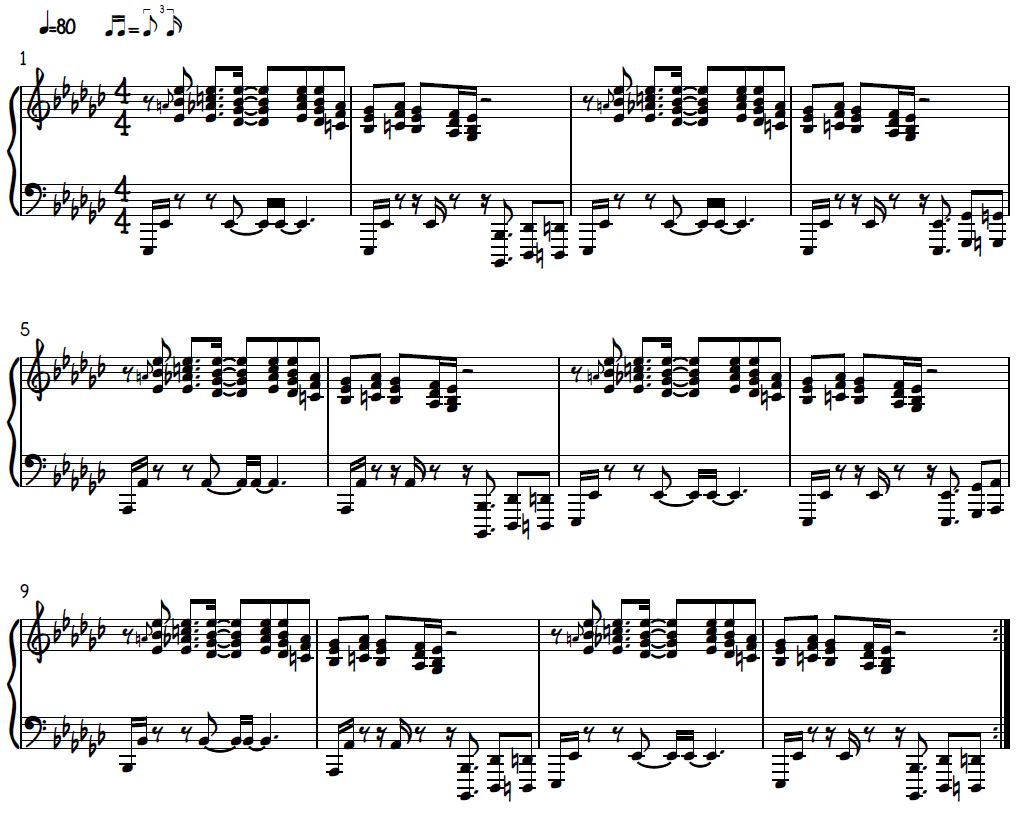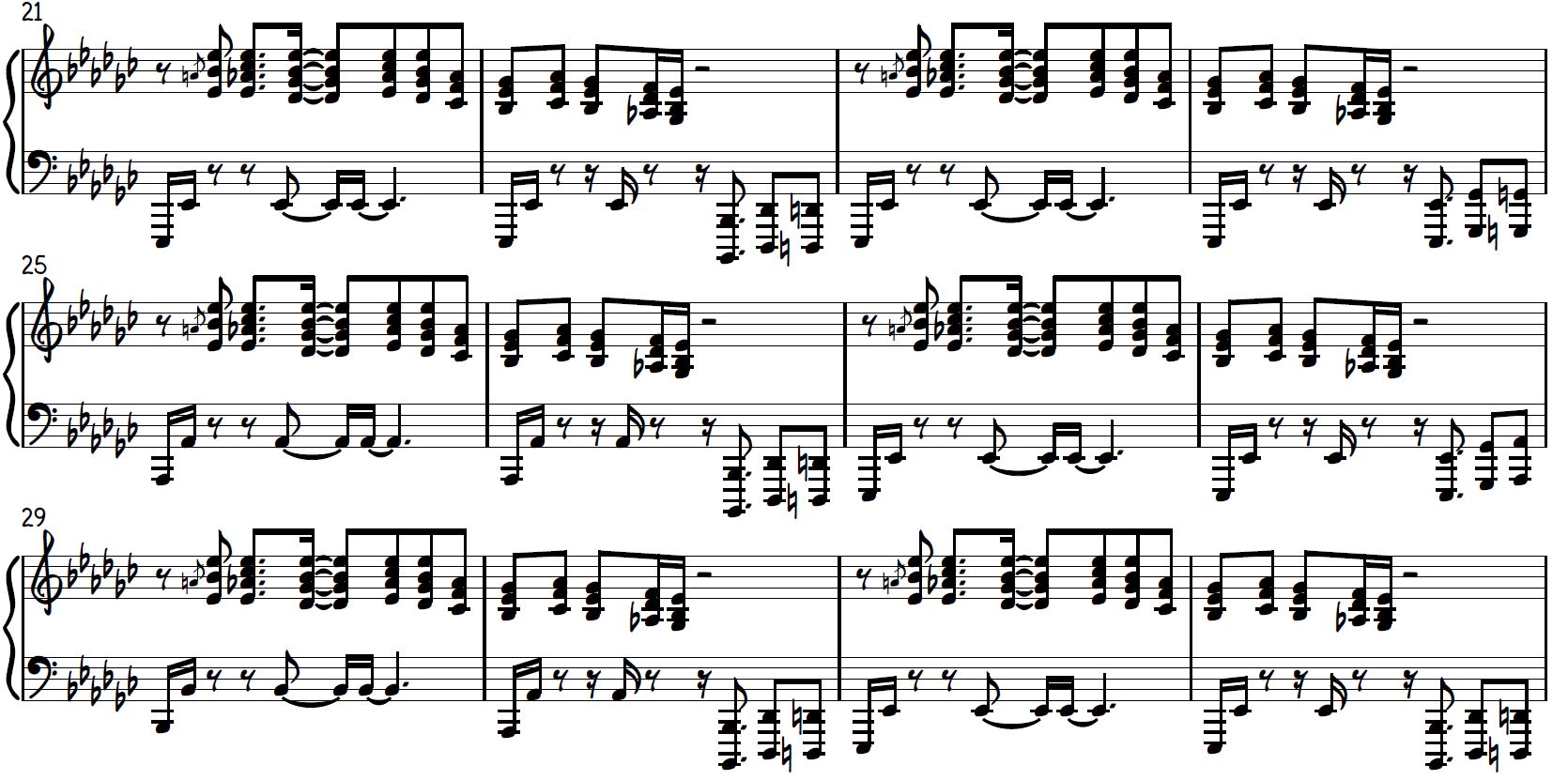Funk Gospel Piano Chords and Bass
Learning Focus
Music Style
Free Lessons
Get free weekly lessons, practice tips, and downloadable resources to your inbox!
Are you ready to jam out on an awesome funk-gospel progression? In today’s Quick Tip, you will learn how to play funk gospel piano chords that sounds great in 3 steps:
1. Learn the riff and theory behind it
2. Learn the bass line
3. Explore improvisation techniques
Feel free to follow along with our Smartsheet as you work through the Quick Tip. Let’s get funky and dig in!
Step 1: Funk Gospel Piano Chords and Theory
Like many styles of American music, funk and gospel draw influence from the blues. Most people are familiar with the blues, but today we will be working with a minor blues. Minor blues is almost identical to the standard blues we all know, except all the chords are minor 7 instead of dominant 7 chords. Let’s take a look at what we will be learning today in its entirety before getting into the details:

This example is an Eb minor blues. Stevie Wonder loves to write and sing in Eb minor (Superstition and Creepin’ are two songs of his in this key) and his influence has helped establish this harmonic flavor in the funk/gospel style. I know this may not seem important, but many songs in this style are written in Eb minor! If you aren’t comfortable in this key, don’t worry. You’ll feel much better about it after working through this Quick Tip!
As always, start working through this riff hands separately. Once you get the first two bars down, the rest of it becomes very easy. Here’s the first two measures with chord symbols written in:

The first thing I notice when looking at this is that the chord symbols don’t match the key signature! Eb minor is the relative minor of Gb Major; this means we should be using Cb instead of C naturals. But C naturals sound so much better! This is because funk and gospel music use the Dorian mode in minor keys. You’ll notice as we move along that regardless of the underlying chord, the notes remain the same. This modal approach makes playing funk-gospel simple and fun! We’ll get into more detail about this in Step 3.
LOOKING AT INDIVIDUAL CHORDS WITHIN THE RIFF
The key to making funk/gospel riffs like this sound good is harmonizing the melody the right way. If we harmonized this same riff according to the key signature, it looks and sounds like this:

That doesn’t sound quite right! As I mentioned above, Dorian mode will give us the right sound. Starting with a simple Eb5 chord, we then harmonize the same melody note with an Ab Major triad. This 2-5 motion within the riff helps give it a funky sound. Next, we have a nice fat Ebm7 chord. Notice the Db on the bottom: this spacing of a 9th between the 7th and root of the chord makes it sound full. Repeat the previous 2 chords to keep that 2-5 motion going.
Next, our melody note changes for the first time to Ab. Here’s where another key component of the funk sound comes into play: harmonizing with triads in second inversion. The rest of the chords are harmonized this way because second inversion triads are also a very funky sound! The combination of 2-5 motion with second inversion triads will make virtually anything sound funky!
Starting from our Ab melody note, we harmonize with an F minor triad, then use Eb minor, F minor, Eb minor, Db Major, and Eb minor at the end. These are all second inversion triads following the melody except for the last chord which is in first inversion. You could also use a second inversion triad here for a slightly different flavor; I would use C diminished. C diminished also creates a cool funky sound because it implies Ab7; it’s the 3rd, 5th, and 7th of Ab7. Both Eb minor and C diminished work however. Play whichever one you like best!
RHYTHM
You can’t have funk without rhythm! The key to making this riff feel good is to subdivide 16th notes throughout. Swing the 16ths for a gospel feel, or play them straight for a more pure funk feel. Funk grooves are created with layers of rhythm working together; you’ve probably noticed that the bass part and riff almost never play at the same time. Practice one measure at a time (or even one or two beats at a time) until you have the rhythm down. It can be helpful to just clap the rhythm with the metronome before you try playing it on the keyboard. If you’re finding it difficult, rest assured that once you get it down, the rhythm is the same for the entire riff! If you can play it once, you can play the whole thing. Next, let’s learn the bass line.
Step 2: Bass Line
Note wise, this bass line is fairly straightforward. The key is the rhythm! Just like with the right hand, subdivide 16th notes. 16th note rhythm often looks much harder than it really is. Here’s what the bass line looks like with subdivisions written in:

Start by clapping and counting the rhythm first, then once you’re comfortable with that add the notes. Practice hands separately and make sure you can play each part individually before trying to play them together. The tricky thing about a funk riff like this is lining up the rhythm correctly between your hands. Go slow until you can play it together, then gradually speed up. You’ll be playing this thing in no time! Finally, let’s look at some improvisation techniques.
Step 3: Improvisation Techniques
There are so many possibilities when it comes to improvising over these funk gospel piano chords! You can use the Eb blues scale, the Eb gospel scale, Eb minor pentatonic scale, slides, turns, and so much more! The simplest way to improvise over this would be to use the Eb minor pentatonic scale. Every note of that scale (Eb, Gb, Ab, Bb, Db) sounds good over every chord, so there’s no need to worry about changing scales with the chords!
You can also use the chords we learned in the riff to improvise with. Second inversion triads are always a great choice to use as well. Try practicing going up the Eb dorian scale by harmonizing each note with a second inversion triad:

Try combining some or all of these techniques as you improvise, and have fun with it!
If you want to dig into more detail about funk improvisation, check out our Funk Improvisation, The Major Blues Scale (Gospel Scale) 1 and The Major Blues Scale (Gospel Scale) 2, Funky Blues Soloing 1 and Funky Blues Soloing 2, Funk & Smooth Jazz Grooves & Licks 1 and Funk & Smooth Jazz Grooves & Licks 2 courses.
Thanks for learning, and see you in the next Quick Tip.
Blog written by Austin Byrd // Quick Tip by Jonny May
More Free Lessons
Struggling to play blues piano with skill and sensitivity? Master these blues piano left hand patterns to take your feel to the next level!
Explore the methods and mindset needed to comp on piano in the swing style with this complete guide to jazz piano comping for all levels.
Discover how to play a pop accompaniment groove with a specific view toward an intentional bass line...examples for all playing levels.
Looking for downloads?
Subscribe to a membership plan for full access to this Quick Tip's sheet music and backing tracks!
Join Us
Get instant access to this Quick Tip and other member features with a PWJ membership!
Guided Learning Tracks
View guided learning tracks for all music styles and skill levels
Progress Tracking
Complete lessons and courses as you track your learning progress
Downloadable Resources
Download Sheet Music and Backing Tracks
Community Forums
Engage with other PWJ members in our member-only community forums
Become a better piano player today. Try us out completely free for 14 days!



